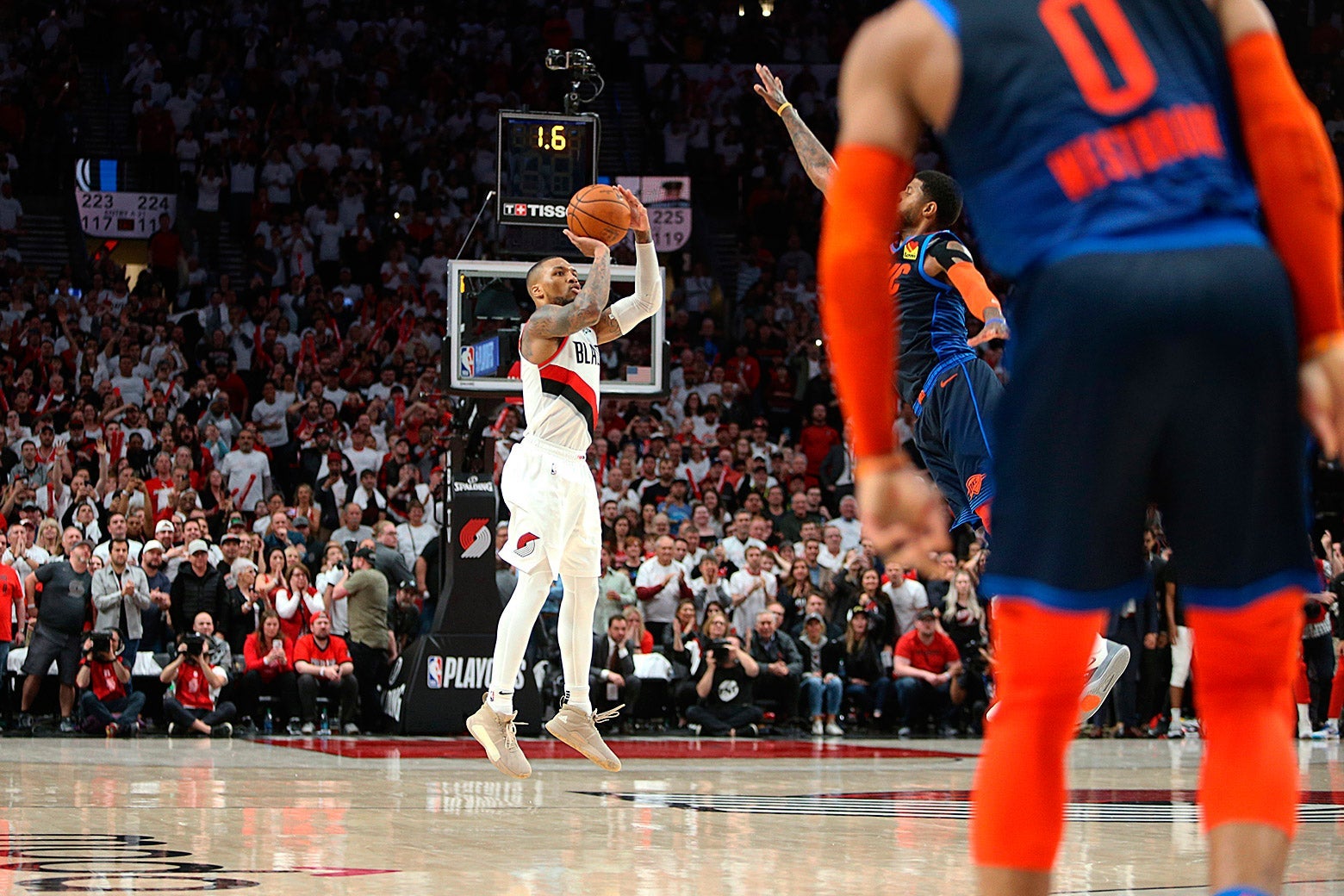
Damian Lillard shoots the game-winning three-pointer to beat the Oklahoma City Thunder 118-115 in Game 5 of the first round of the NBA Playoffs on April 23, 2019.
Sean Meagher/The Oregonian via AP
The NBA 3-point line is (mostly) 23.75 feet away from the basket. It measures just 22 feet in the corners, but that’s still a long distance to throw something. For comparison’s sake, a Chevrolet Suburban is 18 feet long, and that car is so needlessly large that it really shouldn’t exist. Hitting a shot from beyond SUV range should be an impressive feat, but the modern game has turned 3-pointers into quotidian chores. On average, NBA teams now take roughly a third of their shots from behind the arc. It’s early, but the Houston Rockets are on pace to take more 3-pointers than 2-pointers for the third straight season. As a result, we need to adjust our expectations for long-range sharpshooters. Standing out from the crowd now means standing on the center-court logo.
According to Basketball Reference, NBA players made 142 3-pointers from beyond 30 feet during the 2016 regular season. Last year, players converted 265 shots from that distance, which, if you’re measuring from dead center, is about where a team’s on-court logo starts to appear on the hardwood. These aren’t desperate heaves, either. The league’s best shooters use the same form for their ultra-long-range efforts as they do for more pedestrian jumpers.
Because there is no 4-point shot (yet)—you’ll have to watch the BIG3 for that—we need other visual cues to understand these feats of long-range marksmanship. Shots from the center-court logo may not be worth more, points-wise, but they look exponentially more cool. The Portland Trailblazers’ Damian Lillard, an objectively cool guy, earned the nickname “Logo Lillard” after he hit back-to-back 3-pointers from Jerry West’s silhouette during the 2019 All-Star Game.
Lillard may have commandeered the nickname, but he’s not the league’s most prolific shooter from logo-land. Both Steph Curry (18-for-50) and Trae Young (24-for-69) took and made more shots from logo range (30 to 45 feet) last season, though those statistics are slightly deceiving. Center-court logos are different in every arena. The Phoenix Suns’ logo, for example, includes a (scientifically inaccurate) comet tail that juts close to the 3-point line on one end of the floor.
Screengrab via NBA on YouTube.
A shot made from atop that design flourish would technically count as being “from the logo,” even though this would be a paintless patch of parquet in every other arena. Conversely, a long-range attempt near the sideline will easily top 30 feet, but it would be too far off-center to edge into logo territory. That’s why “logo range” isn’t easily conveyable with statistics. You need to see it for yourself.
On-court logos began to appear in NBA in the early 1970s, though they were confined within the 12-feet-diameter of the center circle. A notable exception: the floor at the Milwaukee Exposition, Convention Center and Arena designed by artist Robert Indiana. Installed in 1977, it featured the NBA’s largest and most colorful center-court logo. I doubt that anyone was tempted to shoot from it, however, as I assume the era’s players couldn’t spot the hoop at that distance through all the cigarette smoke.
The earliest mention I could find of “shooting from the logo” in an NBA game appears in a 1993 Daily News write-up of a Knicks loss in Orlando in which John Starks popped a jumper from the Magic logo. That arena featured one of the earliest (non-MECCA) logos that jutted from beyond the normal parameters of the center circle, though it isn’t clear whether Starks took his shot from inside or outside that border. Naturally, he missed.
Starks’ attempt occurred with the clock winding down, but the logo attempts of today are far more casual. (Recall that the goal here is to look cool.) Consider Paul George’s absurdly laid-back logo shot from 2014.
Given the varying shapes and sizes of NBA center-court paint jobs, an argument could be made that any normal-looking shot from an abnormal distance could be considered “from the logo.”
Lillard wasn’t standing on the Moda Center’s pinwheel when he hit his series-winning dagger against the Thunder last year, but the shot exuded Big Logo Energy regardless.
If you can make a 37-footer look that routine, you deserve to have a logo added beneath your feet in post-production. Also deserving of this reverse-Trotsky treatment: Steph Curry’s classic 2016 game-winner against the Oklahoma City Thunder.
Basketball fans are actually pretty chill about what constitutes a logo shot. Did you notice that Luka Doncic’s feet weren’t technically on the Mavericks’ logo in the very first video featured in this post? Probably not, because the audacity of his attempt overrides any possible nitpicking.
Still, we must define our terms, lest anarchy reign. If a casual-looking shot from near the center circle counts as a logo shot, then the opposite is also true. Frantic heaves should have their logo status revoked, even if they’re made by The Logo himself.
Trae Young, the second-year Hawks guard, is the reigning king of logo shooting. In three games this year, he is 2-for-3 on literal logo shots (a term I just coined to denote attempts where one’s feet are actually touching the logo; please credit me as this phrase is bound to sweep the nation). Both makes came against the Pistons in Detroit, and the arena features one of the more restrained logos in the NBA. No comet tails here.
That 32-foot attempt would’ve been considered incredibly ill-advised had it been taken at nearly any other point during the 65-year history of the shot clock. Young had seven seconds remaining on the shot clock, which is an ample amount of time to pass, dribble, or do anything else besides shoot. But shooting is what he does, so why put it off any longer? He was on the logo, and that’s well within his range.
from Slate Magazine https://ift.tt/34eYorL
via IFTTT
沒有留言:
張貼留言